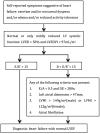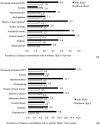Prevalence and Risk Factors of Heart Failure with Preserved Ejection Fraction: A Population-Based Study in Northeast China
- PMID: 27483300
- PMCID: PMC4997456
- DOI: 10.3390/ijerph13080770
Prevalence and Risk Factors of Heart Failure with Preserved Ejection Fraction: A Population-Based Study in Northeast China
Abstract
Background: Heart failure with preserved ejection fraction (HFpEF) has attracted increasing attention worldwide. We aimed to estimate the prevalence of HFpEF and analyze its correlates in a sample of residents of northeast China;
Methods: A population-based study of 2230 participants ≥35 years old was conducted in rural areas of Liaoning Province from January 2012 through August 2013. Information about lifestyle and other potential risk factors was obtained. HFpEF was diagnosed according to the recommendations of European Society of Cardiology;
Results: The overall prevalence of HFpEF was 3.5% (1.8% in men and 4.9% in women). The prevalence of HFpEF increased with age in both genders and was greater in women than in men for every age group. Multivariable logistic regression analysis found that female gender (OR, 3.575; 95% CI, 1.761-7.256), hypertension (OR, 3.711; 95% CI, 2.064-6.674), and history of heart disease (2.086; 95% CI, 1.243-3.498) were associated factors for prevalent HFpEF;
Conclusions: In a general population from rural northeast China, we found that female gender, hypertension, and history of heart disease were risk factors for prevalent HFpEF.
Keywords: heart failure; preserved ejection fraction; prevalence; risk factor.
Figures



References
-
- Schocken D.D., Benjamin E.J., Fonarow G.C., Krumholz H.M., Levy D., Mensah G.A., Narula J., Shor E.S., Young J.B., Hong Y., et al. Prevention of heart failure: A scientific statement from the american heart association councils on epidemiology and prevention, clinical cardiology, cardiovascular nursing, and high blood pressure research; quality of care and outcomes research interdisciplinary working group; and functional genomics and translational biology interdisciplinary working group. Circulation. 2008;117:2544–2565. - PubMed
-
- Brouwers F.P., de Boer R.A., van der Harst P., Voors A.A., Gansevoort R.T., Bakker S.J., Hillege H.L., van Veldhuisen D.J., van Gilst W.H. Incidence and epidemiology of new onset heart failure with preserved vs. reduced ejection fraction in a community-based cohort: 11-year follow-up of PREVEND. Eur. Heart J. 2013;34:1424–1431. doi: 10.1093/eurheartj/eht066. - DOI - PubMed
-
- Lenzen M.J., Scholte op Reimer W.J., Boersma E., Vantrimpont P.J., Follath F., Swedberg K., Cleland J., Komajda M. Differences between patients with a preserved and a depressed left ventricular function: A report from the euroheart failure survey. Eur. Heart J. 2004;25:1214–1220. doi: 10.1016/j.ehj.2004.06.006. - DOI - PubMed
-
- Fonarow G.C., Stough W.G., Abraham W.T., Albert N.M., Gheorghiade M., Greenberg B.H., O’Connor C.M., Sun J.L., Yancy C.W., Young J.B., et al. Characteristics, treatments, and outcomes of patients with preserved systolic function hospitalized for heart failure: A report from the OPTIMIZE-HF registry. J. Am. Coll. Cardiol. 2007;50:768–777. doi: 10.1016/j.jacc.2007.04.064. - DOI - PubMed
MeSH terms
LinkOut - more resources
Full Text Sources
Other Literature Sources
Medical

